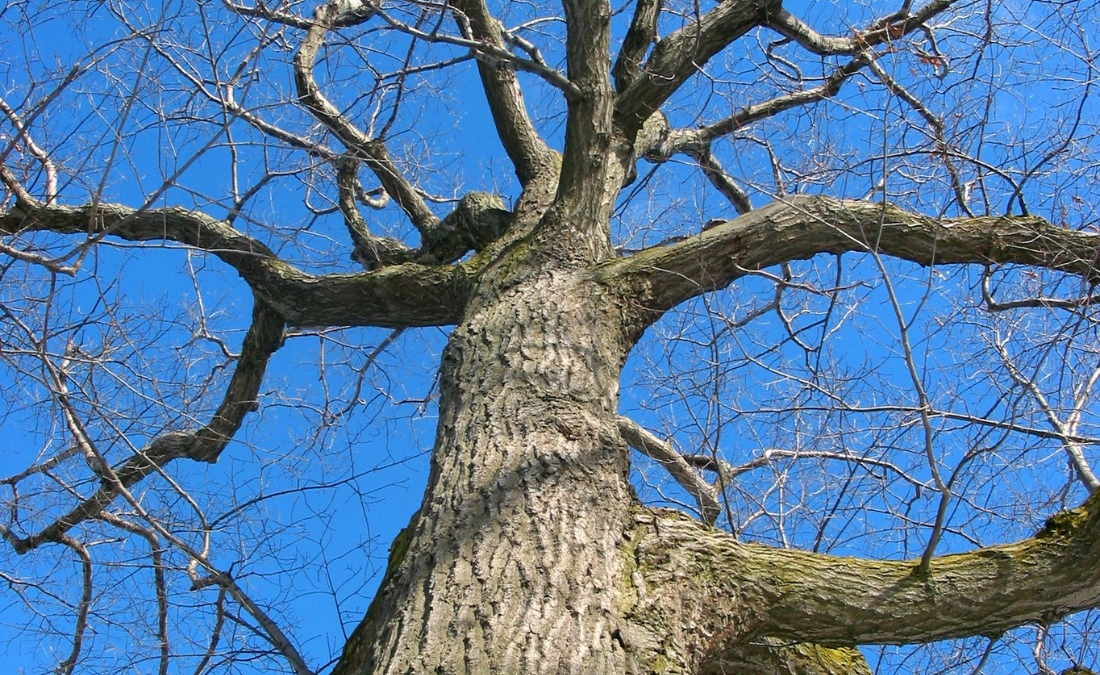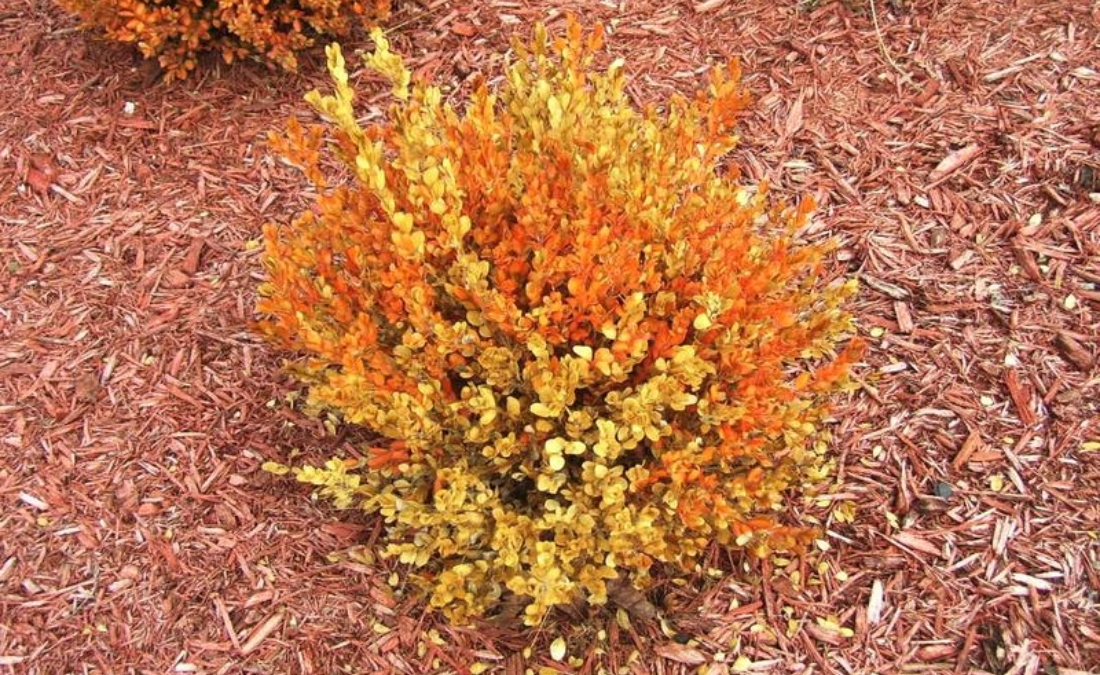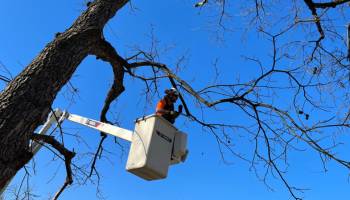Treating Iron Chlorosis: Why Fall Gives Great Plains and Midwest Trees the Best Chance
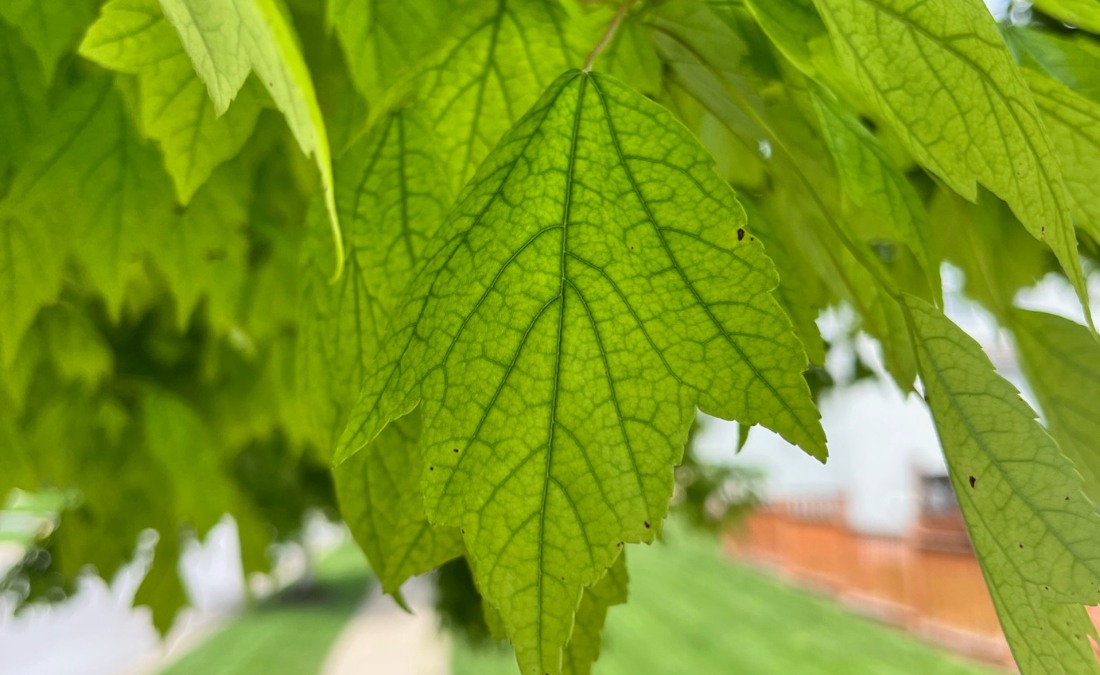
From September to November, trees absorb minerals best. Treat iron chlorosis in the fall to prevent branch dieback, slow growth, and long-term damage.
Have you walked outside this summer and wondered why your beautiful tree suddenly looks sickly yellow? Across the Great Plains and Midwest, more and more trees are showing the same distinct pattern – yellow leaves traced with green veins. It’s a clear sign of iron chlorosis, a nutrient deficiency that quietly weakens thousands of trees in our region each year.
Here’s what many don’t realize: the timing of treatment makes all the difference between success and failure. While most people think summer is the time to address tree problems, treating iron chlorosis during hot months can actually make your trees look worse. The secret lies in understanding when trees can best absorb the minerals they desperately need without additional stress.
Key Takeaways
- Iron chlorosis treatments are most effective from September through November when trees can absorb minerals without heat stress.
- Treating during hot months can worsen leaf appearance and stress trees further.
- Great Plains and Midwest alkaline soils naturally bind iron, making it unavailable to tree roots.
- Mineral injection systems bypass soil pH issues and deliver nutrients directly to the tree.
- Untreated iron chlorosis leads to slow growth, branch dieback, and eventual tree death.
- ISA Certified Arborists can distinguish iron chlorosis from other yellowing causes.
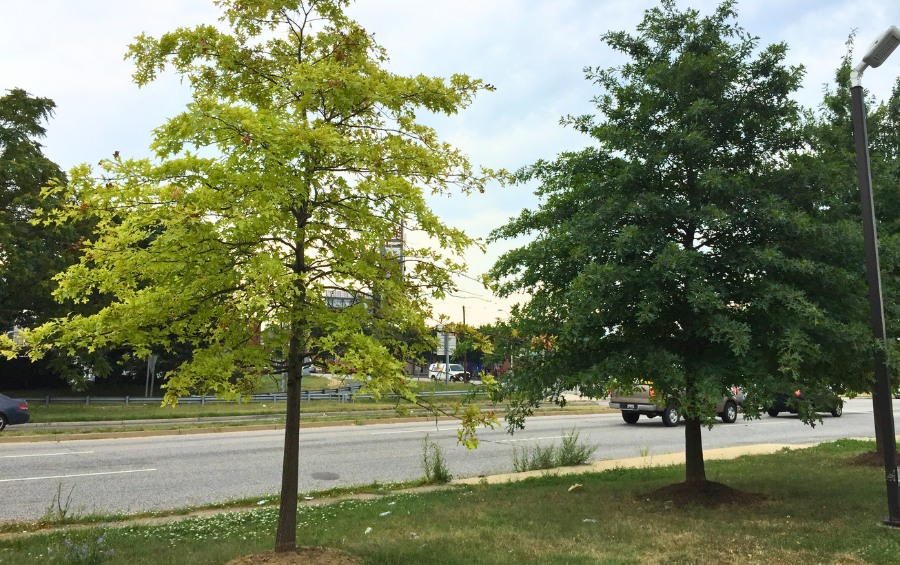
Iron chlorosis symptoms progress from mild yellowing to severe leaf discoloration in alkaline soils. Photo courtesy of Famartin, CC BY-SA 4.0, via Wikimedia Commons.
What Is Iron Chlorosis?
Iron chlorosis appears as a distinctive pattern of leaf yellowing where the tissue between leaf veins turns yellow while the veins remain green. In severe cases, leaves may turn nearly white or develop brown, scorched edges. This condition results from insufficient iron reaching the tree’s chlorophyll production centers, not necessarily from a lack of iron in the soil.
IMPORTANT: Iron chlorosis is not just a cosmetic problem. If allowed to progress, this condition causes slow growth, leaf loss, and eventually tree death. Early intervention during the optimal fall treatment window can prevent permanent damage and restore tree health.
Iron chlorosis often affects only part of a tree initially. You might notice yellowing on one side of the canopy or specific branches while other areas remain green. This uneven pattern helps distinguish iron chlorosis from other conditions like drought stress, which typically affects the entire tree more uniformly.
The problem is, those isolated patches rarely stay that way. Iron chlorosis is progressive, and mild yellowing on new growth can spread and intensify each year. Left untreated, it reduces photosynthesis, slows growth, and leaves trees more vulnerable to drought, insects, and disease.
Which Trees Are Most Susceptible to Iron Chlorosis?
The most susceptible trees in our region include:
- Northern red oak
- Swamp white oak
- River birch
- Silver maple
- Freeman maple
These species evolved in more acidic soil conditions and struggle to adapt to the alkaline soils common throughout the Great Plains and Midwest. Northern red oaks and river birch are particularly vulnerable, often showing symptoms within a few years of planting in alkaline conditions.
Why Great Plains and Midwest Trees Struggle with Iron Absorption
To understand why iron chlorosis is so common in our region, you need to look beneath the surface. The Great Plains and Midwest present unique soil challenges that make it difficult for trees to access the iron they need. These natural conditions, combined with human activities, create the perfect storm for iron deficiency problems.
Alkaline Soil Conditions
The fundamental challenge for trees in our region lies in soil chemistry. Research from Utah State University Extension shows that soils with pH levels above 7.0 make iron increasingly unavailable to plant roots. Most Great Plains and Midwest soils naturally range from 7.5 to 8.5 pH, well into the alkaline range.
In alkaline conditions, iron binds with other soil compounds and becomes insoluble. Even when adequate iron exists in the soil, tree roots cannot absorb it. This explains why simply adding iron to the soil rarely solves iron chlorosis problems in our region.
pH Levels and Mineral Availability
Soil pH affects more than just iron availability. As pH increases, manganese also becomes less available, and the two deficiencies often occur together. This is why effective treatment programs address both minerals rather than focusing solely on iron.
The alkaline conditions in our region also result from natural geological processes. As precipitation decreases moving westward across the Great Plains, soils become increasingly alkaline. The Missouri Botanical Garden explains how this pattern affects nutrient availability for trees across the Midwest. Iron chlorosis is more common in western Kansas and Oklahoma than in eastern Missouri or Iowa due to these precipitation and soil chemistry differences.
Construction Impact and Soil Compaction
Urban development often worsens iron chlorosis problems. Construction activities can raise soil pH through concrete washout, lime-based materials, and disruption of natural soil layers. Compacted soils also reduce oxygen availability to roots, further limiting nutrient uptake.
Many property owners notice iron chlorosis developing several years after construction, as soil conditions gradually change and tree stress accumulates. This delayed onset often catches homeowners off guard, especially when trees initially appear healthy after planting.
The Critical Importance of Treatment Timing
When it comes to iron chlorosis treatment, timing can make the difference between success and failure. Many property owners assume that any time of year works for tree treatments, but iron chlorosis responds very differently depending on when minerals are applied. Understanding these seasonal differences helps ensure your investment in tree health produces the best possible results.
Fall Treatments: The Optimal Window (September-November)
Fall is the best time to treat iron chlorosis in the Great Plains and Midwest. As temperatures cool, trees can take in and move minerals without the added stress of summer heat.
Between September and November, trees naturally shift nutrients from their leaves to their roots for winter storage. This same process helps injected minerals travel throughout the tree, so they’re ready to fuel healthy, green growth in spring.
Another bonus: iron chlorosis treatments can be done alongside other fall fertilization, giving your trees the nutrients they need to recover now and thrive next year.
Summer Treatments: Why They Can Backfire
Treating iron chlorosis during hot summer months can actually make leaves look worse than before treatment. High temperatures and intense sunlight create stress that can lead to phytotoxicity, where the treatment itself damages leaf tissue.
Summer treatments force trees to process new minerals while they’re already stressed by heat and drought. This timing often results in additional leaf browning or scorching, exactly the opposite of what property owners want to achieve.
Professional arborists from Arborjet recommend avoiding treatment during the hottest months, specifically because of these phytotoxicity risks. The stress of treatment combined with summer heat can set back tree recovery rather than helping it.
Spring Treatments: Why Effectiveness Is Limited
While spring treatments are possible, they require much lower dosages to avoid leaf damage as new growth emerges. These reduced rates mean less impact on the tree’s overall mineral status and often produce disappointing results.
Spring-treated trees may show some improvement, but the effect typically doesn’t last as long as fall treatments. The tree’s rapid spring growth quickly uses up available minerals, and symptoms often return by mid-summer.
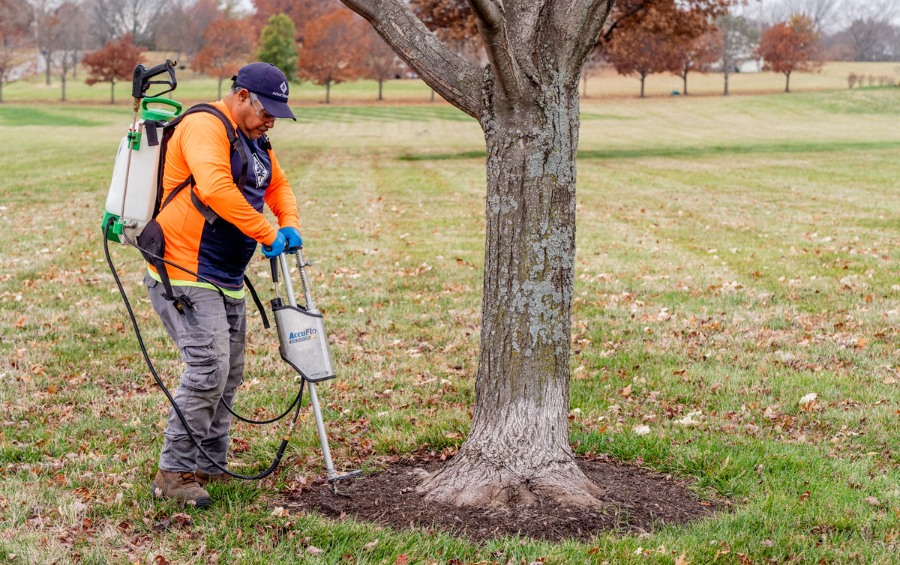
Fall mineral injection treatments provide optimal results without summer heat stress risks.
How Arbor Masters Treats Iron Chlorosis
At Arbor Masters, we’ve refined our iron chlorosis treatment approach over six decades of serving the Great Plains and Midwest. Our process combines advanced injection technology with the expertise of ISA Certified Arborists to deliver minerals exactly where trees need them most. Here’s how we ensure your trees get the professional care they deserve.
ISA Certified Arborist Assessment
Before any treatment, our ISA Certified Arborists conduct a thorough evaluation of each tree. Not all yellowing is caused by iron chlorosis, and proper diagnosis is essential for effective treatment.
Our assessment includes examining leaf patterns, soil testing when necessary, and evaluating overall tree health. We also consider factors like tree age, site conditions, and stress history that might influence treatment success.
This professional evaluation ensures that treatment recommendations are based on actual tree needs rather than assumptions. We’ve seen many cases where property owners assumed iron chlorosis when the real problem was root damage, disease, or other issues requiring different approaches.
MnJet Mineral Injection System
At Arbor Masters, we use the MnJet mineral injection system to deliver iron and manganese directly into the tree’s vascular system. This method bypasses soil pH issues entirely, ensuring that trees receive the minerals they need regardless of soil conditions.
The injection process involves drilling small holes at the base of the tree and introducing mineral solutions under pressure. The tree’s natural circulation carries these minerals throughout the canopy, where they become available for chlorophyll production.
Our mineral formulations include both iron and manganese, as well as other micronutrients that support overall tree health. This comprehensive approach addresses the full range of mineral deficiencies common in alkaline soils.
Treatment Dosage and How Long It Lasts
Treatment rates depend on the severity of chlorosis symptoms and tree size. For slight discoloration, our 5ml rate typically provides coverage for one year. More severe cases with branch dieback may require our 15ml rate, which can provide protection for up to three years.
We adjust treatment protocols based on tree response and site conditions. Some locations with extremely alkaline soils may benefit from supplemental soil treatments to address the underlying pH issues.
When to Expect Visible Improvement
Most trees begin showing improvement within weeks of fall treatment, though the full effect becomes apparent the following spring. New growth typically emerges with much greener foliage, and the overall canopy appearance improves significantly.
Older, more established trees may take longer to show visible results, but internal health improvements begin immediately. These trees often demonstrate better stress tolerance and growth rates even before visible color changes occur.
How to Prevent Iron Chlorosis and Maintain Tree Health
Treating iron chlorosis is important, but preventing it — and keeping your trees healthy long-term — should be the ultimate goal. A proactive care plan not only reduces the risk of nutrient deficiencies but also strengthens trees against drought, pests, and other stressors. Here are strategies we recommend for preventing iron chlorosis and supporting overall tree health:
-
Choose the Right Trees: For new plantings, select species adapted to alkaline soils to prevent iron chlorosis from developing.
-
Improve Soil Health: Use regular fertilization programs with acidifying compounds to boost mineral availability, and follow proper watering and mulching practices to support root health.
-
Mulch Properly: Organic mulch retains moisture, suppresses weeds, and as it decomposes, helps improve soil pH and creates better growing conditions for tree roots.
-
Monitor Regularly: Existing trees with iron chlorosis may need periodic treatments, with frequency based on soil conditions, tree response, and environmental stresses.
-
Maintain and Prune: Regular pruning removes dead or damaged branches, allowing the tree to focus its energy on healthy growth and better utilize available minerals.
Frequently Asked Questions
When is the best time to treat iron chlorosis?
September through November provides the optimal treatment window. Fall timing allows trees to absorb minerals without heat stress and prepares them for healthy spring growth. Summer treatments should be avoided due to phytotoxicity risks.
How long do iron chlorosis treatments typically last?
Treatment duration depends on the application rate and tree condition. Light treatments may provide one year of coverage, while higher rates can protect trees for up to three years. Soil conditions and tree stress levels also influence longevity.
Can iron chlorosis be prevented in alkaline soils?
Prevention strategies include selecting alkali-tolerant tree species, improving soil drainage, and using acidifying fertilizers. However, in severely alkaline soils, periodic mineral injection treatments may be necessary even for preventive care.
How do I know if my tree has iron chlorosis or another problem?
Iron chlorosis creates yellow leaves with green veins, often starting on new growth or one side of the tree. This differs from drought stress (overall yellowing) or disease (spots, wilting, or unusual patterns). Professional diagnosis ensures proper treatment.
Is iron chlorosis treatment safe for my landscape?
Professional mineral injection treatments are safe when performed by trained arborists. The process creates small injection sites that heal quickly, and the minerals used are specifically formulated for tree application. Proper timing minimizes any stress to the tree.
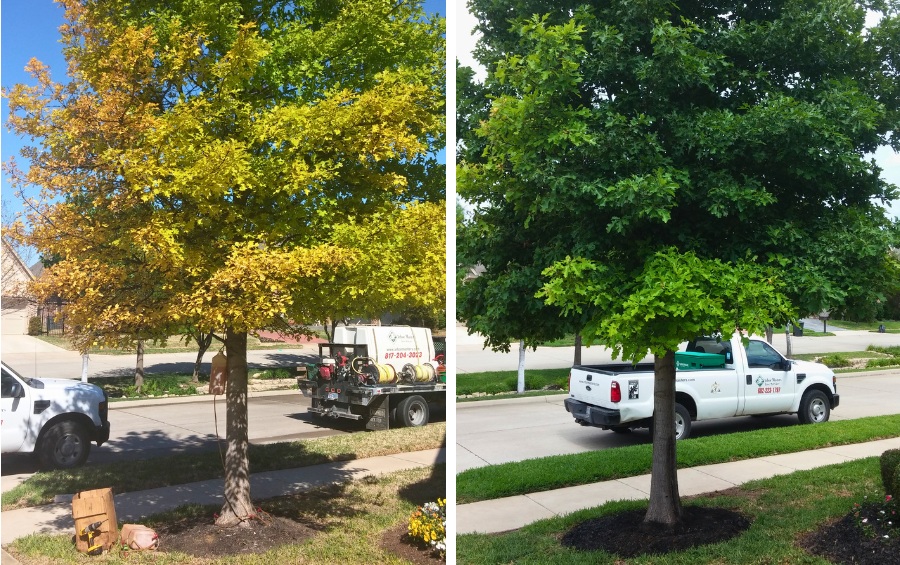
Professional iron chlorosis treatment typically shows results within weeks to months.
Protect Your Trees with Expert Iron Chlorosis Treatment from Arbor Masters
Iron chlorosis doesn’t have to threaten your valuable trees. With proper timing and professional treatment, most affected trees can recover completely and maintain healthy growth for years to come. Fall is the best time to address iron chlorosis effectively while avoiding the risks associated with summer treatments.
At Arbor Masters, our ISA Certified Arborists bring over 60 years of regional experience to iron chlorosis treatment. We understand the unique challenges of Great Plains and Midwest soils and use proven mineral injection systems to restore tree health safely and effectively.
Don’t wait for iron chlorosis to worsen. Contact Arbor Masters today at 405-495-8746 to schedule your fall tree evaluation. Our team will assess your trees’ condition and develop a treatment plan that protects your investment while preserving the beauty and value of your landscape. Request your free estimate and give your trees the expert care they deserve.

Get the latest local news, tree care tips, special offers, and company updates directly to your inbox! It's easy to subscribe and there's no spam - we promise.
"*" indicates required fields



